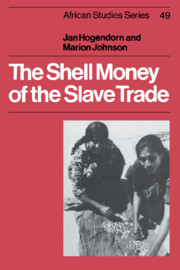Book contents
- Frontmatter
- Contents
- Maps
- Tables and chart
- Preface
- Introduction
- 1 The cowrie
- 2 The Maldive Islands
- 3 The Portuguese domination
- 4 The Dutch and English enter the trade (seventeenth century)
- 5 Prosperity for the cowrie commerce (eighteenth century)
- 6 Boom and slump for the cowrie trade (nineteenth century)
- 7 Collection, transport and distribution
- 8 Cowries in Africa
- 9 The cowrie as money: transport costs, values and inflation
- 10 The last of the cowrie
- Notes
- Bibliogaphy
- Index
7 - Collection, transport and distribution
Published online by Cambridge University Press: 12 October 2009
- Frontmatter
- Contents
- Maps
- Tables and chart
- Preface
- Introduction
- 1 The cowrie
- 2 The Maldive Islands
- 3 The Portuguese domination
- 4 The Dutch and English enter the trade (seventeenth century)
- 5 Prosperity for the cowrie commerce (eighteenth century)
- 6 Boom and slump for the cowrie trade (nineteenth century)
- 7 Collection, transport and distribution
- 8 Cowries in Africa
- 9 The cowrie as money: transport costs, values and inflation
- 10 The last of the cowrie
- Notes
- Bibliogaphy
- Index
Summary
The collection, transport, and distribution of the shells was an unique exercise quite unlike any other export of Asia or import to Africa. The mechanism that was firmly in place at the start of the eighteenth century worked smoothly for the most part, even though the “invisible hand” of Adam Smith shared its grip with monopoly and monopsony at several stages.
“PRODUCTION” OF THE SHELLS
It might be assumed that the shells could simply be plucked off Maldive beaches and loaded into ships for export. Such a view would be wholly wrong on two accounts. First, if the inhabitant of the shell were already dead and the cowrie had been rolled along the sand by waves and tides, its enamel would be worn and its lustre much diminished. Shells in this condition were fragile, useless for ornamentation, and were often rejected for money use, or commanded a lower price. Second, if the animal was still alive when put into a ship's hold, it would not long remain so and there would soon be an overpowering stench. “Dead Maldives,” a sales category at the European auctions, were of the first type – collected after the mollusc had died. “Live Maldives,” the major category, were not however shells shipped with a live mollusc inside. Such a practice was rare, although one nineteenth-century writer does describe the “stinking and very unhealthy” condition of cargoes shipped with the living creature still resident at the start of the voyage. Instead, “live Maldives” were shells that had been processed, and even the word “manufacture” is perhaps appropriate.
These considerations led to methods of collecting the shells with their inhabitants alive, and processing them to rot out the animal matter.
- Type
- Chapter
- Information
- The Shell Money of the Slave Trade , pp. 80 - 100Publisher: Cambridge University PressPrint publication year: 1986

